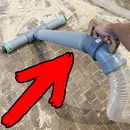Introduction: Insulated Attic Hatch
This ´ible is about how to build an insulated attic hatch for cheap!
I am currently renovating an old building to turn it into a multi-flat rental property. Since the weather is getting colder by the day up here in the northern hemisphere I had to quickly find a way to keep the warmth inside the house. The biggest heat loss was due to the staircase to the attic so I decided to build a hatch for it.
This project, of course, is just to showcase how to build something like that. That´s why I won't be giving out any precise measurements. I doubt even if you ever build something like this, it would be in a 100+year-old crooked house.
The project was quite easy. It took me less than a day to build it and I used only basic power tools. The only time I needed assistance was when I started installing the hatch. I tried to make it as light as possible but due to the insulating material, it turned out t be a bit too heavy to be lifted alone. The total cost of this build for me was around 60€.
Be sure to check out the build video and if find the content interesting I welcome you to subscribe and leave your thoughts in the comment section.
Step 1: Tools and Materials
As I said I used only basic tools for this build. Even some that I used were not really necessary. Probably hand saw and a screwdriver would suffice :D
Tools I used, were:
- Circular saw
- Impact driver
- Miter saw
- Electric planer
- Laser level, spirit levels
- Measuring tools
- Marking tools
Materials I used are really basic and most likely readily available in any lumberyard.
- 2x10 timber for the outer frame (undried was the only one available in my case)
- 1x8 timber for hatch frame (should be dry)
- 2 sheets 6mm OSB
- Insulating material - sawdust in my case
- Different woodscrews
- Gasket tape
Step 2: Building the Outer Frame
The idea here is to create a flat surface all around the opening for the hatch to sit on. I used 2X10 material for it. I screwed the timber in place with 120 mm woodscrews making sure it was plum. A great tool for making sure the timber is creating a flat surface on top is a laser level. Just set it nearby and use measuring stick and the vertical beam to make sure all the timber is at the same height and plum.
I had to trim the handrail on the left side to attach the lumber. I did this with a circular saw making sure there wasn't any metal on the cut line.
At the end of the stairs, I added a small piece of timber and then planed it to match the height of the rest of the timber.
Step 3: Frame of the Hatch
This frame was built from 1x8 material. I built everything around 2 cm smaller from the outer frame so that the hatch could actually be opened. I used mostly miter saw to cut everything to a length just because it is a bit more precise and cleaner cut than using a regular circular saw. Everything was screwed with 70 mm woodscrews. As I was using soft pine for this build I really did not bother pre-drilling since it quite hard to split the wood.
The cross board at the angled end was done using two boards that were overhanging on both ends. These ends were then cut down with a circular saw on an angle and planed flat with an electric planer.
Step 4: Adding the Insulation and Completing the Sandwitch
Next step was to add a sheeting material on one side of the sandwich. I added the lower one first but it could be done either way. I used 6 mm OSB since it was cheap and lightweight. If I were ever to build it again I would probably use a bit thicker OSB on the top since the edges of the top are supporting the whole hatch. Drywall screws were used to attach the OSB.
Now comes insulation. One could probably use any insulation for this but weight is the key factor. I decided to use sawdust as insulation only because I have a ton of it. The awesome thing about it is that it´s completely natural and harmless and since I am a woodworker it´s free for me. The downside of it is that it´s a bit heavy and probably not as good insulator as for example mineral insulations.
Anyway, if you use sawdust be sure to compact it tightly since the hatch will be tilted. Otherwise, overtime voids would form on one edge creating cold bridges.
Cut the top sheet to size making sure there is around 6cm of overhang on all the edges. Since the OSB is so thin I used some more timber on both shorter ends to give it some more strength.
Step 5: Install the Hatch and Enjoy!
The last step is to install the hatch. As I said earlier it could be quite heavy so be sure you have a couple of people to help you lift it. My younger brother helped me and we managed it nicely.
Add some wide gasket tape under the overhanging face to further help with airtightness.
Whenever I need to open the hatch I put my back against it and lift with my legs. When up, I put a rope around it to hold it up. To be honest this is not the best method and I probably need to come up with some sort of counterweight and pulley system to help lift it. The little piece of wood underneath is to make absolutely sure the rope would not slip.
So be sure to follow and subscribe to not miss out any content that I post.
If you have any questions or ideas on how to improve it be sure to leave them down in the comment section!
Thanks for reading!
Andu













